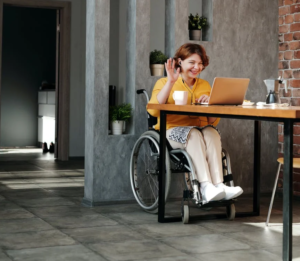
COVID-19 is a global pandemic that has changed the lives of many. While no one was prepared for it, this situation left people wondering what to do next — especially business owners. Some had to close up shop, while others decided to accommodate the circumstances by allowing their employees to work from home.
The switch to telework may be exciting for some, however, it isn’t the best fit for everyone. This article will explain how remote work impacts people with disabilities in both a positive and negative way.
Telecommuting, Employers, and the ADA
As the Covid-19 pandemic took shape, many employers were forced to make accommodations so their employees could work from home. This may include allowing them to take home their work computers and other equipment used in the office to allow them to work from home. Remote work continues to become widely accepted by employers. In fact, an estimated 34% of workers are currently working from home. And 74% of organizations are willing to switch selected employees to a permanent remote position after the COVID-19 pandemic.
This may be because employers are discovering the multiple benefits of working from home. For instance, remote work benefits include:
- A better balance between work and personal life;
- The ability to customize your workspace;
- Increased productivity;
- No office distractions or gossip;
- Not having to stress over the commute to work;
- Reducing the negative effects on the environment that are associated with your daily commute;
- The ability to spend more time with your children.
Aside from recognizing more of the advantages of working from home, employers are also beginning to see what the future holds for telecommuting in general. Statistics show that telecommuting has increased by 91% over the last 10 years, and will continue to grow.
Advantages
No matter what your ability is there are benefits to working from home. Along with the general benefits of working from home like the ones mentioned above, people with disabilities, in particular, can employ certain assistive technologies and may work better in remote environments than in a traditional office setting.
Eliminates Commuting and Transportation Struggles
For some disabled individuals, commuting to work is a daily struggle. Working remotely eliminates this commute entirely and any struggles associated with it, including:
- Waking up early to get a ride to work;
- Finding a way to transport a wheelchair, crutches, walker, and other assistive devices;
- Worrying about medical emergencies contingent with disabilities (i.e. anxiety attack, bowel and/or bladder problems, fatigue that could result in falling asleep at the wheel.
Assistive Tech That’s Already in the Home
Some people with physical disabilities require assistive technology. While some may have the help of an OT or OTA, others rely on technology and other devices already in their homes, including but not limited to:
- Canes;
- Crutches;
- Lifts, ramps, and railing;
- Scooters;
- Walkers;
- Wheelchairs;
- Instant access to music to help block out auditory distractions and hallucinations;
- Calendar reminders programmed on their phones, laptops, and other personal devices;
- A program that helps them with medication management.
Disadvantages
Alongside common remote-work downfalls like having to invest more in creating a home office space, risk of overworking, and being exposed to more distractions — there are multiple disadvantages that could make working from home while disabled difficult.
Lack of Socialization
Working remotely reduces these interactions and can limit people from getting face-to-face socialization they might desire. Socialization is important because it:
- Allows people to feel a part of a community, which can help boost esteem levels and self-confidence;
- Gives individuals a sense of purpose and belonging;
- Improves mental and emotional health;
- Reduces blood pressure and risk of cognitive decline;
- Stimulates brain health by engaging in conversation and other activities that require socialization.
Potential Lack of Guidance
Working from home means little to no one-on-one, in-person training sessions between employees and managers. This can be difficult for those who require hands-on learning and need that extra guidance to succeed in their role.
Scheduling an appointment with a specialized occupational therapist can help an individual learn different self-guided exercises they can do at home. These at-home exercises provided by the OT can improve the employee’s mental and physical health — which can lead to increased work productivity and overall employee satisfaction.
Image Source: https://www.pexels.com/